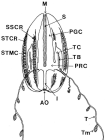WoRMS taxon details
Euplokamis dunlapae Mills, 1987
265174 (urn:lsid:marinespecies.org:taxname:265174)
accepted
Species
marine, brackish, fresh, terrestrial
Mills, C.E. (1987). Revised classification of the genus <i>Euplokamis</i> Chun, 1880 (Ctenophora: Cydippida: Euplokamidae n. fam.), with a description of the new species <i>Euplokamis dunlapae</i>. Canadian Journal of Zoology, 65: 2661-2668.
page(s): 2662-2666, figs. 1-5 [details]
page(s): 2662-2666, figs. 1-5 [details]
Note Friday Harbor Laboratories dock
Type locality Friday Harbor Laboratories dock
[details]
[details]
Mills, C.E. Internet (1998-present). Phylum Ctenophora: list of all valid species names. Electronic internet document. Euplokamis dunlapae Mills, 1987. Accessed through: World Register of Marine Species at: https://www.marinespecies.org/aphia.php?p=taxdetails&id=265174 on 2024-09-24
Date
action
by
![]() The webpage text is licensed under a Creative Commons Attribution 4.0 License
The webpage text is licensed under a Creative Commons Attribution 4.0 License
original description
Mills, C.E. (1987). Revised classification of the genus <i>Euplokamis</i> Chun, 1880 (Ctenophora: Cydippida: Euplokamidae n. fam.), with a description of the new species <i>Euplokamis dunlapae</i>. Canadian Journal of Zoology, 65: 2661-2668.
page(s): 2662-2666, figs. 1-5 [details]
basis of record van der Land, J. (ed). (2008). UNESCO-IOC Register of Marine Organisms (URMO). , available online at http://www.marinespecies.org/urmo/ [details]
additional source Mills, C. E. (1998-present). Phylum Ctenophora: list of all valid species names. [Internet]., available online at http://faculty.washington.edu/cemills/Ctenolist.html [details]
page(s): 2662-2666, figs. 1-5 [details]
basis of record van der Land, J. (ed). (2008). UNESCO-IOC Register of Marine Organisms (URMO). , available online at http://www.marinespecies.org/urmo/ [details]
additional source Mills, C. E. (1998-present). Phylum Ctenophora: list of all valid species names. [Internet]., available online at http://faculty.washington.edu/cemills/Ctenolist.html [details]
 Present
Present  Present in aphia/obis/gbif/idigbio
Present in aphia/obis/gbif/idigbio  Inaccurate
Inaccurate  Introduced: alien
Introduced: alien  Containing type locality
Containing type locality
From editor or global species database
Type locality Friday Harbor Laboratories dock[details]
Type specimen "Ctenophores do not preserve well, so type specimens are not available for further examination." [details]
From regional or thematic species database
Diagnosis DiagnosisEuplokamis with ovate shape (narrowing at the oral end) and somewhat flattened in the tentacular plane. With comb rows extending two-thirds to three-quarters of the body length and the meridional canals extending a short distance beyond the comb rows toward the oral and aboral poles. With red pigmentation at the edges of the comb rows, on the tentacle basal complexes, and on the distal, coiled portion of the tentilla. [details]

